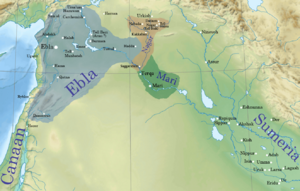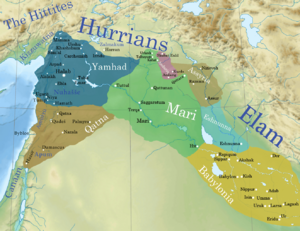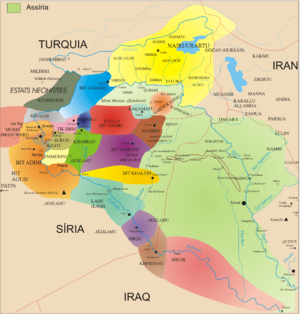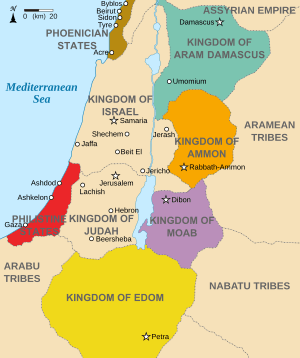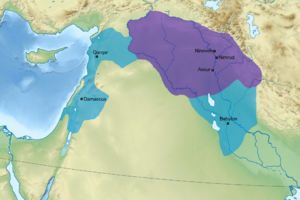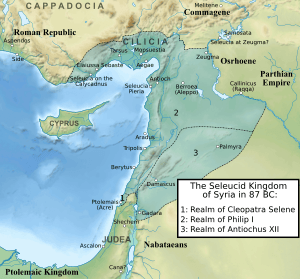History of the ancient Levant facts for kids
The Levant is a special area in Southwest Asia. It's south of the Taurus Mountains, with the Mediterranean Sea to its west. To the south is the Arabian Desert, and to the east is Mesopotamia.
This region stretches about 400 miles (640 km) from north to south. It goes from the Taurus Mountains to the Sinai desert and Hejaz. From east to west, it lies between the Mediterranean Sea and the Khabur river.
Today, the Levant usually includes parts of Turkey (like the Hatay Province), Syria, Lebanon, Israel, Palestine, and Jordan. Sometimes, it also includes Cilicia, Cyprus, and the Sinai Peninsula.
The Levant is one of the first places where people started living in one spot and farming. Some of the earliest farming cultures, like the Pre-Pottery Neolithic, began here. For a long time, people thought the Levant was just a small area next to bigger civilizations like Mesopotamia and Egypt. But now, many experts see it as its own important center of civilization.
During the Bronze and Iron ages, many ancient Semitic-speaking peoples and kingdoms lived in the Levant. Many believe it's where Semitic languages first started.
Contents
Ancient Times in the Levant
Stone Age Discoveries
Modern humans, called Homo sapiens, lived in the Mount Carmel area around 90,000 BC. These early people came from Africa. However, they might not have stayed, as Neanderthal groups seemed to take over by 60,000 BC.
Later, around 52,000 to 50,000 BC, another group of modern humans moved out of Africa. They brought new tools and ways of life. By 40,000 BC, the region was home to the Levanto-Aurignacian culture. This culture was very successful and spread widely.
New Tools and Dog Friends
After the last Ice Age, a new culture called the Kebaran culture appeared. They used tiny stone tools called microliths. These tools suggest they used bows and arrows and had even started to tame dogs. The Kebaran culture lasted from 18,000 to 10,500 BC.
The Kebaran culture led to the Natufian culture (12,500–9,500 BC). These people were pioneers in building the first settled villages. They might have gotten food by fishing and collecting wild grains. In 2018, the oldest bread remains were found from around 12,400 BC. This was at a Natufian site, long before farming became common.
The Natufian culture also showed the earliest signs of dog domestication. Dogs likely helped with hunting and guarding villages. This helped the Natufian culture spread. In northern Syria, the Natufian culture developed into the first fully farming societies. They grew wild grains and later raised domesticated sheep and goats.
Farming and Early Villages
By 8500–7500 BC, the Pre-Pottery Neolithic A (PPNA) culture grew from the Natufian ways. They lived in round houses. They built the first defensive wall at Tell es-Sultan (ancient Jericho) to protect a valuable spring. Around 7500 BC, the Pre-Pottery Neolithic B (PPNB) culture took over. They built square houses and came from northern Syria.
During this time, another group called the Harifian culture lived in Sinai. They might have learned to use pottery from Egyptian cultures. Later, they joined with PPNB people to form the Syro-Arabian pastoral group. This group spread the first Nomadic pastoralists (people who move with their herds) in the Near East. These nomadic people helped lay the groundwork for later groups like the Martu and Akkadian peoples.
In Syria's Amuq valley, the PPNB culture continued to develop. Nomadic groups mixed with PPNB people to form new cultures like the Minhata Culture. These cultures spread south, starting the classic mixed farming way of life in the Mediterranean. From 5600 BC, they were linked to the Ghassulian culture, the first Copper Age culture in the Levant. During this time, large stone structures called megaliths also began to appear.
Historically, the Bedouin people have been nomadic herders and farmers in the Syrian steppe since 6000 BC. By 850 BC, they had a complex network of settlements. The earliest Arab tribes came from these Bedouins.
Copper Age Beginnings
Kish Civilization Idea
The idea of a "Kish civilization" was once used to describe an early period in Mesopotamia and the Levant. It was thought to include places like Ebla and Mari in the Levant, and early Akkadian sites like Kish. This idea suggested a shared culture starting in the early 4th millennium BC. However, more recent studies don't use this term anymore.
Bronze Age Kingdoms
Early and Middle Bronze Age Life
In the Syrian part of the Levant during the Bronze Age, scholars use specific names for time periods. "Early/Proto Syrian" is for the Early Bronze Age (3300–2000 BC). "Old Syrian" is for the Middle Bronze Age (2000–1550 BC). "Middle Syrian" is for the Late Bronze Age (1550–1200 BC). The "Neo-Syrian" period is the early Iron Age.
The Early Syrian period was ruled by kingdoms that spoke East Semitic languages. These included Ebla, Nagar, and Mari. At its largest, Ebla controlled a huge area, almost half the size of modern Syria. It had over sixty smaller kingdoms and city-states under its rule. Mobile nomadic groups also lived in the steppes south of Ebla.
Later, Sargon of Akkad and his successors took over Ebla and Mari. This was part of the Akkadian Empire. But the empire fell apart around 2200 BC due to a major climate change. This led to many nomadic Amorites moving into the area.
The Amorites became very powerful in the ancient Near East for centuries. They founded many kingdoms, including the Old Babylonian Empire. Famous Amorite rulers included Hammurabi, the king of Babylon, and the warlord Shamshi-Adad I.
In southern Mesopotamia, Babylon became a major power under Amorite rulers. In northern Mesopotamia, Shamshi-Adad I created a large, but short-lived, kingdom. In the Levant, Amorite families ruled kingdoms like Qatna, Ebla, and Yamhad. Another group, the Suteans, were fierce nomadic warriors and often worked as mercenaries.
Amorite people also had an influence in Egypt. Some rulers in the Nile Delta had Amorite names. The Hyksos, who later ruled Egypt, were a mix of different groups from the Levant, including Amorites.
Outside Powers Take Control
By the 16th and 15th centuries BC, most major cities in the Levant were taken over and declined. Mari was destroyed, and Yamhad and Ebla were completely ruined by the Hittite king Mursili I around 1600 BC. In northern Mesopotamia, the Amorite states were defeated by Assyrian kings. In Egypt, Ahmose I drove out the Hyksos rulers. The Amorites eventually disappeared from history, absorbed by other groups like the Arameans.
Between 1550 and 1170 BC, Egypt and the Hittites fought over much of the Levant. This power struggle allowed the rise of Mitanni, a kingdom with mixed Semitic and Hurrian speakers. Egyptian rule was strong over the Canaanite cities in Palestine. They faced resistance from nomadic groups like the Shasu. The Shasu became so strong that they blocked Egypt's northern trade routes.
After the Egyptians left, Canaanite cities were left open to attacks from the Shasu and Habiru. Egyptian control in the southern Levant completely collapsed during the Late Bronze Age collapse.
The Great Collapse of the Bronze Age
Around the 12th century BC (1200 to 1150 BC), all these powerful empires suddenly fell apart. Centralized governments collapsed, and the region suffered from famine. There was chaos everywhere. Many cities were burned down by hungry locals and groups of raiders called the Sea Peoples. The Sea Peoples eventually settled in the Levant. Their origins are still a mystery, with theories suggesting they came from places like Troy or Sardinia.
Cities that had survived earlier wars, like Ugarit and Megiddo, were completely destroyed and never rebuilt. The Hittite empire was ruined. Egypt barely managed to fight off its attackers. Over the next century, Egypt shrank and its central government became much weaker.
Iron Age Changes
Despite the difficult start, the Iron Age brought many new inventions. The most important were iron working and the Phoenician alphabet. The Phoenicians developed their alphabet around the 11th century BC. It came from an older script and possibly combined ideas from Egyptian Hieroglyphs and Cuneiform.
The huge destruction at the end of the Bronze Age wiped out most major kingdoms and cities. The early Iron Age in Syria and Mesopotamia saw people spreading out into smaller settlements. Many hamlets, villages, and farmsteads appeared.
Northern Levant Kingdoms
After the Bronze Age collapse, much of Syria was ruled by Aramean tribes and states. They quickly spread across Syria and Mesopotamia. Their expansion led to conflicts with the Assyrians. Some major Aramean kingdoms included Aram-Damascus, Hamath, and Bet-Adini. In northern Syria, the fall of the Hittites and the rise of the Arameans led to new kingdoms called the Syro-Hittite states. These states spoke both West Semitic and Anatolian languages.
The Chaldeans, another West Semitic group from the Levant, moved into Babylonia. They often rebelled against the Assyrians. Assyrian texts from the 9th century BC also mention the Arabs (Aribi). They lived in parts of the Levant and near the Babylonian border, often mixed with the Arameans.
Along the coast of northern Canaan, the Phoenician city-states survived the Bronze Age collapse. They became powerful trading nations by sea. They set up colonies all across the Mediterranean Sea, in places like Sardinia, North Africa, and Spain. One famous colony, Carthage, later became a strong independent city.
The Phoenicians also spread their alphabet through their trade networks. This alphabet was later adopted and developed into the Greek alphabet and then the Latin alphabet.
Southern Levant Groups
During the Iron Age, many groups lived in the southern Levant. The most well-known were the Philistines and the Hebrews/Israelites. Nomadic herding groups began to settle down in the 11th century. The Israelites slowly built many small communities in the central highlands. The Philistines, who were immigrants from the Aegean region, arrived around 1175 BC and settled on the southern coast of Canaan.
By the seventh century BC, at least eight nations lived in the southern Levant. These included the Arameans of Geshur, the Samaritans in Samaria, the Phoenicians in the north, and the Philistines in their five main cities. There were also three kingdoms in Transjordan: Ammon, Moab, and Edom. Finally, there were the Judaeans of the Kingdom of Judah.
Under Foreign Rule
Assyrian Control
In the Iron Age, the Levant had many small kingdoms and tribal groups. Sometimes, these groups united against powerful neighbors. For example, in the Battle of Qarqar (853 BC), Arameans, Phoenicians, Israelites, Ammonites, and Arabs joined forces against the Assyrians. They managed to stop the large Assyrian army.
However, the political situation changed. The anti-Assyrian alliance broke apart. The Assyrians eventually conquered the Levantine states after many campaigns, especially under Tiglath-Pileser III (745–727 BC). Assyrian rule led to many revolts. The anti-Assyrian groups were finally defeated by 732 BC. Aram-Damascus was taken over, and its people were moved. The Kingdom of Israel was destroyed, and its people were taken into Assyrian captivity.
The Arameans were fierce fighters. Because of this, Assyrian kings started to recruit them into their army. By the time of Shalmaneser V (727–722 BC), Aramean tribes were a key part of the empire. They helped secure the empire's borders. This likely helped Aramaic become the main language of the empire.
Neo-Babylonian Rule
After the Battle of Carchemish, the Neo-Babylonians became very powerful. Nebuchadnezzar II attacked Jerusalem and destroyed the Temple in 597 BC. This started the Babylonian captivity, where many people were taken to Babylon for about 50 years. Nebuchadnezzar also attacked the Phoenician city of Tyre for 13 years.
However, the Babylonian power didn't last long. In the 550s BC, the Achaemenids (Persians) rose to power. They took over many kingdoms, including Babylonia and Egypt. Their vast empire stretched all the way to India. This huge kingdom was divided into areas called satrapies. The Persians ruled with a lighter hand than the Assyrians. Babylon became one of their capitals, and Aramaic remained the common language. Around this time, Zoroastrianism became the main religion in Persia.
Classical Age Empires
Hellenistic Rulers
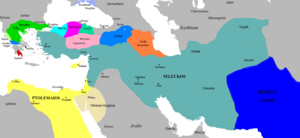
The Achaemenid Empire ruled the Levant after 539 BC. But by the 4th century BC, the Persians were getting weaker. The Phoenicians often rebelled against them because of heavy taxes. The Judeans, however, were allowed to return from their exile by Cyrus the Great.
The campaigns of Xenophon showed how vulnerable Persia was to armies organized like the Greeks. Eventually, Alexander the Great conquered the Levant in 333-332 BC. But Alexander died young in 323 BC. After his death, most of his eastern empire went to the family of Seleucus I Nicator, who founded the Seleucid Empire. Seleucus built his capital at Seleucia in 305 BC, but it was later moved to Antioch in 240 BC.
Alexander and his Seleucid successors built many Greek-style cities (poleis) in Syria. These cities were settled by soldiers and locals. The Seleucids also encouraged Greeks from different parts of Greece to settle in military towns. This is where Koine Greek developed and became the common Greek language. Koine Greek was used for government and trade, but Aramaic remained the main language in rural areas. Cities were mostly bilingual. During this time, Hellenistic culture formed, mixing ancient Greek culture with local Syrian, Babylonian, and Egyptian cultures. The Seleucid kings even called themselves 'Basileus (King) of Syria'.
Some Hellenistic cities founded in the Levant by Alexander and the Seleucids include:
- Antioch (the capital)
- Apamea
- Decapolis (a group of ten Greek cities)
- Laodicea
- Seleucia Pieria
- Larissa in Syria
- Cyrrhus
- Chalcis ad Belum
The Greek settlers were used to form the Seleucid army. While the Seleucids recruited from smaller groups like Arabs and Jews, they generally avoided recruiting native Aramean Syrians and Babylonians. This was likely to prevent giving weapons and training to the majority population in their main cities.
Local Kingdoms Rise Again
The Seleucids slowly lost control of their lands in the east. This limited their empire to the Levant. This decline in power led to several independent states forming in the Levant.
In the north, Ptolemaeus declared himself king of Commagene in 163 BC. The Arab Abgarids ruled Osroene independently from 132 BC. The Maccabean Revolt in Palestine led to the Hasmonean kingdom in 140 BCE. The Nabataeans in the south had their own kingdom since the 3rd century BC. These events left the Seleucids as a weak state, only controlling parts of Syria and Lebanon.
Roman Period
The Romans took control of the region in 64 BC. They defeated the Seleucids and Tigranes. Pompey removed the last Seleucid king and made Syria a Roman province. However, the Romans slowly brought local kingdoms into their empire, giving them some freedom in local matters.
The Herodian Kingdom of Judea replaced the Hasmonians in 37 BC. It became the province of Judaea in 44 CE. Commagene and Osroene were added in 72 and 214 CE. Nabatea became the province of Arabia Petraea in 106 CE.
Between the 1st and 3rd centuries CE, the Levant's population grew to an estimated 3.5 to 6 million people. Cities like Antioch and Palmyra had 200,000–250,000 residents. Many new religions and philosophies appeared. Christianity started as a Jewish group and became its own religion by the mid-2nd century.
The region of Palestine or Judea had conflicts between Romans and Jews. The First Jewish–Roman War (66-73 CE) led to the destruction of Jerusalem and the Second Temple in 70 CE. Later, the Bar Kokhba revolt (132-136 CE) erupted. After this, the province of Syria Palaestina was created in 132 CE.
During the Crisis of the Third Century, the Sassanids invaded the Levant. A Syrian leader from Palmyra, Odaenathus, gathered an army. He defeated the Persians and even attacked their capital. Odaenathus became "King of Kings of the East." After his death, his wife Queen Zenobia took over. In 270 CE, Zenobia broke away from Roman rule and created the Palmyrene Empire. She quickly conquered much of Syria, Egypt, and parts of Asia Minor. However, by 273 CE, Zenobia was defeated by the Roman emperor Aurelian.
After the Roman Empire permanently split in 391 CE, the Levantine provinces became part of the Byzantine Empire. In the southern Levant, the Ghassanid Arabs became a client state of the Byzantines. They helped protect against Sassanid attacks and nomadic raids. As Christianity grew, Jews became a minority in the southern Levant.
The terrible Byzantine–Sasanian War of 602–628 ended with the Byzantines winning back the land. But the empire was exhausted and taxed its people heavily. The Levant became a battleground, which caused many people to move away.
Muslim Conquest and Rule
Eastern Roman control over the Levant ended in 636 CE. Arab armies conquered the Levant, and it became part of the Rashidun Caliphate. It was known as Bilād ash-Shām.
Under the Umayyads, the capital moved to Damascus. Unlike in Iraq, there wasn't a huge migration of Arab tribes to the Levant. Historical evidence suggests that most people continued to live in their homes after the Muslim conquest. Muslim troops settled alongside locals in existing cities like Damascus, Homs, and Jerusalem. The Umayyads also relied on local Syrian Arab tribes for their army. These were Arab tribes who lived in the Levant before Islam.
When the Abbasids moved the capital to Baghdad in 750 CE, they focused on Iraq and Iran. This led to the Levant being neglected and experiencing many uprisings. Syria became a center for anti-Abbasid feelings. Different groups, some supporting the Umayyads and others the Shiites, rebelled.
The growing Isma'ili movement moved its headquarters to Salamiyah in 765 CE. From there, missionaries spread their ideas to many regions. In 904 CE, an Isma'ili leader moved to Morocco. His missionaries helped establish the Fatimid empire by 909 CE.
See also
- Names of the Levant
- History of the Middle East
- List of archaeological periods (Levant)
- Ancient Near East
- Levantine archaeology
- Near Eastern bioarchaeology
- History of the ancient Levant
- History of Cyprus
- History of Palestine – same as "History of Israel", with a non-Jewish focus
- History of Israel i.e. of the "land of Israel" – same as "History of Palestine", with a Jewish focus
- History of Jordan
- History of the Sinai Peninsula
- Prehistory of the Levant
- History of Islam
Images for kids
-
An official from Avaris with a mushroom-headed hairstyle.


